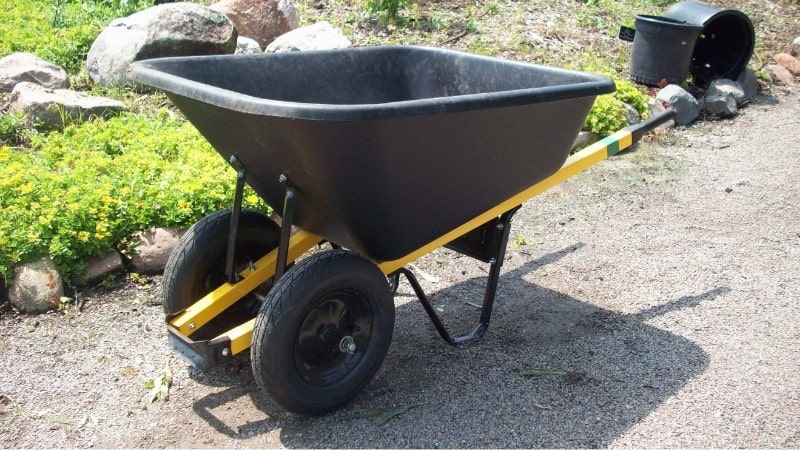The wheel was invented in 3,500 B.C, and in 200 AD, the wheelbarrow was invented. Since then, the wheelbarrow has taken many forms and aided in various sectors like farming, construction, trade, and landscaping.
Wheelbarrows are also being built in different sizes to meet specific operational requirements. One thing people have been curious about is the size and dimensions of the wheelbarrow.
These hand-propelled vehicles have only one wheel, which makes them even lighter. If you are among those interested in learning about the dimensions of a wheelbarrow, this is where you should be. We break down the dimensions of different wheelbarrows and how they compare.
How wide is a Standard Wheelbarrow?

The standard wheelbarrow for home or backyard gardening use is about 17 inches (45 cm) wide. These wheelbarrows have a carrying capacity of between 4 and 6 cubic feet. This width also allows easy passage through narrow entryways.
How long is a Wheelbarrow Handle?

Wheelbarrow handles come as pairs of metal and wood. Depending on the tray size, they can be from 50 to 60 inches (127-152 cm) long and 2 inches (5 cm) wide. The handle ends sometimes have vinyl, plastic grips of fiberglass to allow for handling. These grips do not impact the handles’ length because they fit the edge.
Standard Wheelbarrow Tray Dimensions
Trays or bins are the main parts of the wheelbarrow where goods are loaded for hauling. Some are even foldable to allow for maneuverability. Tray capacities are given in cubic feet depending on the location and brand. Standard wheelbarrows can be anywhere from 4 to 12 cubic feet. The standard dimensions are given as follows;
- Length: 36-45 inches (91-114 cm)
- Width: 26-36 inches (66-91 cm)
- Depth: 21-40 inches (53-101 cm)
Average Wheelbarrow Wheel Size

All wheelbarrows must have wheels because you cannot move any load without them. Wheelbarrow wheels can be plastic, rubber, foam, or wood, but the sizes tend to be equal.
A standard wheelbarrow wheel has a diameter of 16 inches (40.6 cm) and a thickness of 4.1 inches (10.4 cm). However, these figures may change depending on the carrying capacity of the wheelbarrow.
Standard Wheelbarrow Height
The height of a wheelbarrow is measured from the ground to the highest point of the tray. The capacity of the wheelbarrow may determine the overall height because some are compressed while others are wider. The wider the tray/bucket, the shorter the entire wheelbarrow.
The taller the tray, the higher the wheelbarrow will be. Besides the tray, the wheels also help determine a wheelbarrow’s height. On average, wheelbarrows are only 27 inches (68.6 cm) high, while some can go past 35 inches (89 cm).
Dimensions of a 4 Cubic Feet Wheelbarrow

The 4 cubic feet wheelbarrow is an excellent choice for most homeowners due to its storage-friendly size. In addition, these wheelbarrows have shorter wooden or steel handles for easy handling.
The wheelbarrow itself is 4.48 feet (136.5 cm) long, 1.8 feet (21.97 cm) high, and 26.70 inches wide (67.90 cm). The handle is 55.5 inches (141 cm) long, and the tray 36.5 inches long. The space between the handles is 20 inches wide for easier holding of the handles.
They also have pneumatic, solid rubber tires, which are 13.2 inches (33.7 cm). On average, 4 cubic feet of wheelbarrows weigh 27.06 lbs. (12 kg) and can carry 160 pounds (73 kg).
Dimensions of a 6 Cubic Feet Wheelbarrow
The 6 ft3 wheelbarrows are primarily used as a garden wheelbarrow for transporting garden supplies and lawn equipment. It has a metal tub with either wooden or steel handles or a pneumatic wheel.
The average 6 cubic feet wheelbarrow is 38 inches (96 cm) long, 26 inches (66 cm) wide, and 9 ½ inches (24 cm) deep. The handles are about 60 inches (152 cm) long with a 2-inch (5 cm) tapper and 21 inches (53 cm) apart which allow maneuverability in different terrains.
The wheelbarrows also have pneumatic wheels, which are 4 inches (10 cm) thick and 16 inches (40.6 cm).
Dimensions of a 7 Cubic Feet Wheelbarrow
7 cubic feet of wheelbarrows are somehow bigger to be considered for everyday home usage. Some have only one wheel, while some use two wheels for more flexibility. The holding tray is 26.8 inches (26.8 cm) wide, 40 inches (101 cm) long, and 19 inches (48 cm) high. T
hese wheelbarrows have their weight distributed to the wheels to allow easy lifting, pushing, and dumping. The steel handles are 62-65 inches (157-165 cm) long, which allows better load balancing. They also have rubber or foam-filled wheels, 16 inches (40.64 cm) in diameter and 4 inches (10.16 cm) wide.
With such a robust construction, you can expect the load capacity to be over 352 pounds (160 kg).
Dimensions of an 8 Cubic Feet Wheelbarrow
8 cubic feet of wheelbarrows are great for easily moving mounds of loads, leaves, and dirt. These wheelbarrows are great for home construction projects, and some have two wheels to improve the ergonomic design that allows easy control when handling heavy loads.
The average 8 ft3 wheelbarrow tray is 39 inches (99 cm) long, 32.70 inches (81 cm) wide, and 21.50 inches (54.6 cm) wide. The overall length of the wheelbarrow is 60.2 inches (152 cm), the height from the ground is 30.5 inches (30.5 cm), and it weighs 41.3 pounds.
The handles are 60 inches (152 cm) each with rubber grips. The tire’s diameter is 16 inches (40.64 cm) and 4.1 inches (10.4 cm) wide for more surface contact.
Dimensions of a 10 Cubic Feet Wheelbarrow

10 cubic feet of wheelbarrows are rare because they are mostly preserved for heavy construction and industrial jobs. Depending on the brand, they can either be plastic or steel or mostly come with two wheels to manage heavy loads.
A standard 10 cubic feet wheelbarrow is 44 inches (111 cm) long, 36 inches (91 cm) wide, and 19 inches (48 cm) deep. They also have 60-inch (152 cm) steel handles for balanced handling. Each of the two pneumatic wheels has a diameter of 16 inches (40.64 cm).
These dimensions make the wheelbarrow strong enough to handle over 480 pounds (217 kg) load. It can therefore be used for construction and heavy jobs in various terrains.
Dimensions of an Electric Wheelbarrow
Apart from electric cars, there are electric wheelbarrows that can carry from 8 cubic feet of load. These wheelbarrows have four wheels for safe pushing up and down all kinds of terrains. The wheelbarrow also has compact dimensions for easy access to tight and restricted areas. The dimensions of a standard electric wheelbarrow are given as follows;
- Width: 66 cm ((80 cm with castor wheels)
- Height: 31 inches (80 cm) front 28 inches (72 cm) rear
- Tray Length: 38 inches (97 cm)
- Tray width: 26 inches (65 cm)
- Wheel diameter: 16 inches (40 cm)
Dimensions of the Largest Wheelbarrow in the World

The largest wheelbarrow in the world was recorded in Boke, Germany, by Heimatverein Boke, e.V (Germany). In 2015, the Guinness world records found a wheelbarrow that is 37 feet (11.28 m) long and with a wheel diameter of 9’ 2.6” (2.81 m). However, there have been claims of other bigger wheelbarrows in the world.
How do you Measure the Dimensions of a Wheelbarrow?
Wheelbarrows can be as small as 2 cubic feet and as big as 10 cubic feet. Using the dimensions of the wheelbarrow, you can calculate the area to determine the holding capacity. It is great if you need to haul material and consider space.
- Measure the bottom of the wheelbarrow from the back to the front slope.
- Measure the wheelbarrow’s interior width from side to side at the front and back.
- Measure the depth of the holding vessel from the bottom to the top rim.
- Multiply the length by the width to determine the volume of the square part of the holding vessel. For example, if it is 2 feet long and 2 feet wide by 2 feet deep, you get 8 ft3.
- Measure the length of the sloping front part of the wheelbarrow. Considering the lip is curved at the front, measure from the point halfway between the lip’s center and where the curve meets the straight sides. When you measure from the center, where the wheelbarrow has the deepest projection, you will have a volume bigger than the actual volume. From there, measure back from where the slope begins, where you stopped the initial length measurement from the main part of the wheelbarrow.
- Multiply the length by the width and depth measurements you took in the first part of the wheelbarrow. Then, divide the figure by half to compensate for the 45-degree angle. For example, if you measure the front slope of the wheelbarrow and get 1 foot, multiply it by 2 to get roughly 2 cubic feet for the front wheelbarrow portion.
- Add the rear and front portion volumes to get the wheelbarrow volume. For example, if the rear part of the wheelbarrow is 8 cubic feet and the front is 2 cubic feet, the total volume is 10 cubic feet.
That is all you need to know about wheelbarrow dimensions and sizes. With this information, you can be certain that you can tell the dimensions of a wheelbarrow by just looking at it. Additionally, the dimensions can help you pick a wheelbarrow that meets your size specifications. However, these sizes should not be used to make purchase decisions but as a reference point to help you learn.
The dimension of stuff has been an interest of mine ever since I was a child. What I believe is most fascinating about the dimension of stuff is how extremely long, tall and wide some objects are both on earth and in the universe.

